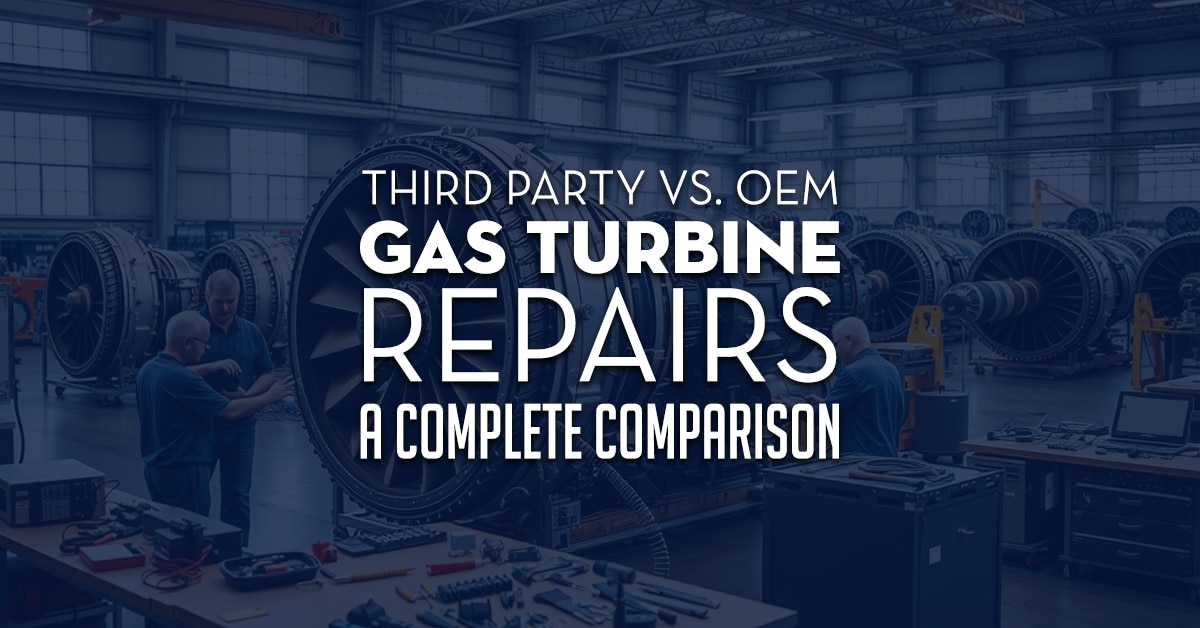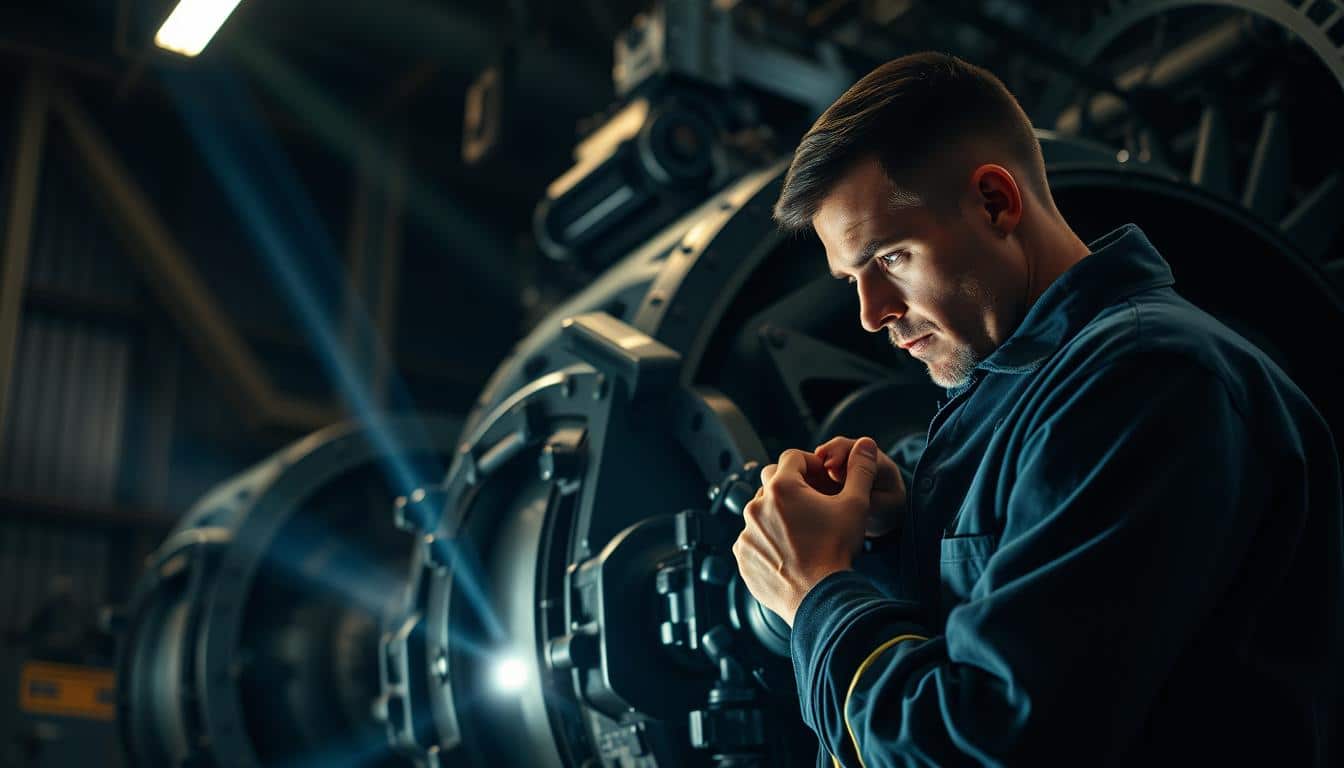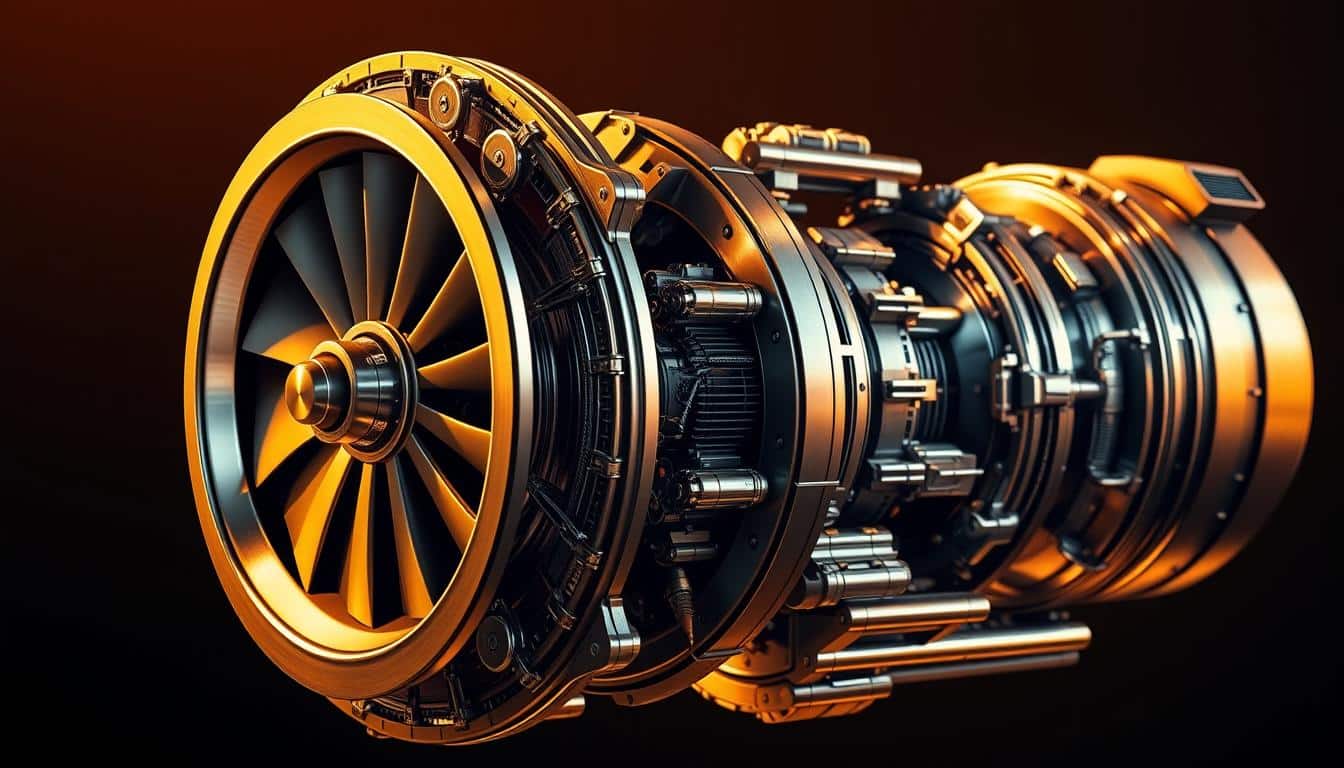As a power plant operator, you’re constantly faced with critical decisions about maintaining and repairing your gas turbines. The retrofit market for gas turbine control systems is set to grow significantly. You must consider the pros and cons of working with original equipment manufacturers (OEMs) versus third-party repair providers. This detailed comparison aims to guide you in making choices that enhance reliability, reduce maintenance costs, and boost your power plant’s turbine performance.
The debate between OEMs and independent suppliers reveals each side’s unique strengths. OEMs highlight the benefits of upgrading their original control systems. On the other hand, third-party providers emphasize the flexibility of open architectures and the availability of new replacements.
As you explore service agreements and look for cost savings without sacrificing quality, it’s vital to grasp the differences between these two options. This knowledge is essential for making smart decisions.
Key Takeaways:
- The gas turbine retrofit market is poised for significant growth as systems from the 1990s and early 2000s require upgrades
- OEMs and third-party repair providers offer distinct advantages in terms of expertise, responsiveness, and cost
- Understanding the differences between OEM and third-party services is critical for making informed maintenance and repair decisions
- Balancing reliability, cost savings, and performance is key to optimizing your power plant’s turbine services
- Partnering with the right provider can help you minimize downtime, extend equipment life, and maximize ROI
Introduction
As a power plant operator, ensuring your gas turbine’s reliability and cost-effectiveness is vital. You face a critical choice: should you go with the original equipment manufacturer or consider third-party services? This decision impacts your plant’s performance and maintenance costs.
This detailed comparison will help you weigh the pros and cons of OEM versus third-party gas turbine repair services. Understanding the expertise, turnaround time, cost structures, and part access will guide your choice. This knowledge optimizes your plant’s performance and reduces maintenance expenses.
We will examine the strengths and weaknesses of both OEM and third-party providersfor power generation repairs. This will help you find the best match for your needs. Whether you value proprietary knowledge, custom solutions, or long-term savings, our analysis will support your strategic decisions. These choices will boost your gas turbine’s reliability and efficiency.
By the end of this comparison, you’ll grasp:
- The roles and capabilities of OEMs and third-party providers
- Service scope and technical proficiency differences
- The turnaround time and responsiveness impact on operations
- Cost comparisons and strategies for long-term savings
- Access to parts and components for timely repairs
With this knowledge, you can confidently navigate the complex world of gas turbine repair services. This ensures your power plant runs efficiently while keeping maintenance costs under control. Let’s explore the key considerations that will shape your decision-making process.
Understanding the Players
When looking at gas turbine maintenance and repair, two major players stand out: original equipment manufacturers and third-party providers. It’s vital to grasp the distinctions between these entities to make well-informed decisions. This knowledge is key to ensuring your turbine services run smoothly and efficiently.
What Is an OEM?
OEMs are the pioneers in designing, engineering, and manufacturing gas turbines. Giants like GE, Siemens, and Mitsubishi Power Systems fall into this category. These OEMs provide extensive support throughout their equipment’s lifecycle. This includes:
- Original parts and components
- Upgrades and enhancements
- Technical expertise and engineering support
- Warranty coverage and extended service agreements
Choosing an OEM for gas turbine maintenance and repair grants plant operators access to the manufacturer’s deep understanding of their equipment. It also opens the door to exclusive resources.
Who Are Third-Party Gas Turbine Repair Providers?
Third-party providers are independent entities focused on gas turbine maintenance, repair, and overhaul services. Companies like Allied Power Group offer an alternative to OEM support. They specialize in customized solutions and flexible service options. The benefits of working with third-party providers include:
| Advantage | Description |
|---|---|
| Cost savings | Competitive pricing and flexible service bundles |
| Responsiveness | Agile service delivery and reduced lead times |
| Customization | Tailored solutions to meet specific plant needs |
| Multi-OEM expertise | Experience servicing various turbine models and brands |
While third-party providers might not have access to all OEM proprietary resources, they innovate. They develop alternative parts, repair techniques, and service strategies to increase reliability and availability for gas turbine units.
Service Scope & Capabilities
Plant operators face a choice in maintaining and repairing gas turbines: OEM or third-party maintenance. Each option has its pros and cons, mainly in service scope and capabilities.
Comprehensive Lifecycle Support from OEMs
OEMs provide deep lifecycle support with their proprietary knowledge. They handle everything from routine maintenance to complex repairs. Their specialized diagnostic tools and expertise ensure quick and effective issue resolution.
Agile, Customized Solutions from Third-Party Providers
Third-party providers are known for their agile, custom services. They tailor solutions to each plant’s unique needs, providing flexibility in scheduling and budget. Their experience across various turbine models allows for innovative performance optimization.
Comparing Diagnostic, Field, and Shop Repair Services
Comparing diagnostic, field service, and shop repair capabilities is key. The table below offers a side-by-side comparison:
| Service | OEM | Third-Party |
|---|---|---|
| Diagnostic | Proprietary tools and deep product knowledge | Advanced analytics and cross-platform expertise |
| Field Service | Global network of trained technicians | Rapid response and flexible scheduling |
| Shop Repair | Access to original parts and specifications | Cost-effective solutions and reverse engineering capabilities |
OEMs use their proprietary knowledge and global resources to their advantage. Yet, third-party providers offer agility, customization, and cost-effective solutions. The right choice depends on your specific needs, budget, and operational priorities.
Expertise and Technical Proficiency
When it comes to gas turbine repairs, expertise and technical proficiency are essential for quality and compliance. OEMs and third-party providers each offer unique strengths, yet their methods vary significantly.
Engineering Depth: OEM’s Proprietary Knowledge vs Third-Party Innovation
OEMs have deep, proprietary knowledge of their turbine systems and designs. This allows them to perform repairs that meet exact original specifications. In contrast, third-party providers innovate by introducing new repair methods, reverse engineering parts, and adopting advanced technologies. These efforts aim to boost performance and efficiency.
The table below compares the engineering strengths of OEMs and third-party providers:
| Engineering Aspect | OEM Strengths | Third-Party Strengths |
|---|---|---|
| Design Knowledge | Deep proprietary understanding of original equipment design | Reverse engineering capabilities to replicate or improve designs |
| Repair Techniques | Follows original manufacturing processes for consistent results | Develops innovative repair methods to enhance performance or lower costs |
| Technology Adoption | Incorporates proven technologies validated by OEM testing | Faster adoption of new tools, materials, and processes to stay competitive |
Certifications, QA Standards, and Industry Compliance
It’s vital to check certifications, quality assurance standards, and compliance with industry regulations, regardless of your choice between OEM and third-party providers. Leading providers hold ISO certifications, adhere to rigorous QA processes, and keep abreast of standards from bodies like API and ASME.
The decision between OEM and third-party expertise hinges on your specific needs and priorities. If sticking to OEM specifications is critical, an OEM repair might be ideal. Yet, for innovative solutions, quicker service, or cost savings, a skilled third-party provider could be the better option for your gas turbine repairs.
Turnaround Time & Responsiveness
In the realm of gas turbine repairs, the importance of turnaround time and responsiveness cannot be overstated. These factors directly influence your plant’s productivity and profitability. The goal is to minimize downtime, and the choice between OEM and third-party repair providers significantly impacts this goal.
Typical Lead Times from OEMs
OEMs have established processes for gas turbine repairs, ensuring quality but sometimes at the expense of speed. Their lead times can vary based on repair complexity, parts availability, and their workload. This variability can affect how quickly your turbine is restored to operation.
How Third-Parties Reduce Downtime
Third-party repair providers stand out by focusing on reducing downtime. They employ agile processes and prioritize turnaround time. Their strategies include:
- Streamlined diagnostic and repair procedures
- Flexible scheduling and priority service options
- Extensive parts inventory and global sourcing networks
- Dedicated project management to ensure efficient workflows
By focusing on speed and efficiency, third-party providers aim to minimize the impact of repairs on your plant’s operations.
Emergency Response & Field Service Availability
In critical situations, emergency response and field service availability are key. When evaluating repair providers, consider the following:
| Factor | OEM | Third-Party |
|---|---|---|
| 24/7 Emergency Support | Variable | Often Standard |
| On-Site Service Teams | Limited Availability | Widely Available |
| Response Time Guarantees | Rare | Commonly Offered |
Third-party providers excel in emergency response and field service. They have dedicated teams ready to deploy at a moment’s notice. Their flexibility and focus on minimizing downtime are invaluable when every second counts.
Cost Comparison: Total Cost of Ownership (TCO)
When looking at gas turbine repair options, it’s key to think about the total cost of ownership (TCO). This goes beyond the initial repair cost. It includes pricing models, cost structures, flexibility, bundles, cost controls, and long-term savings. Understanding the TCO helps you make smart budget decisions and cut costs over your turbine’s life.
Navigating OEM Repair Pricing Models
Original Equipment Manufacturers (OEMs) stick to set pricing models and cost structures for repairs. These might include fixed prices for certain packages, time and material rates, or performance-based contracts. While OEM pricing is predictable, it might not fit unique plant needs or budgets well.
Unlocking Flexibility with Third-Party Providers
Third-party gas turbine repair providers offer more flexibility in pricing, bundles, and cost controls. They can customize services to fit your needs, with tailored repair packages and flexible payment options. Their innovative solutions help you save on repair costs without sacrificing quality or reliability.
Achieving Long-Term Cost Savings
When looking at the TCO of gas turbine repairs, long-term savings are critical. Third-party providers can lead to big savings over your turbine’s life through:
- Competitive pricing and flexible cost structures
- Customized repair solutions that focus on cost-effectiveness
- Improved turbine efficiency and performance, cutting fuel costs
- Extended equipment lifespan through proactive maintenance and repairs
Working with a trusted third-party provider lets you adopt cost-saving strategies. These strategies bring lasting value to your plant operations.
Access to Parts and Components
Access to spare parts and components is vital for gas turbine repairs. Plant operators must weigh the pros and cons of OEM versus third-party parts. This decision impacts inventory, lead times, and cost-effectiveness.
OEM Proprietary Parts: Advantages and Limitations
OEMs control proprietary turbine components, providing advantages. OEM parts meet exact specifications, ensuring performance and reliability. Yet, this exclusivity can limit pricing, availability, and flexibility.
Third-Party Solutions: Expanding Options with Equivalent Parts
Third-party providers offer innovative solutions for spare parts. They source equivalent, refurbished, or reverse-engineered parts. This expands options beyond OEM components, reducing costs and improving availability.
Navigating Inventory Availability and Lead Times
Effective inventory management is key for minimizing downtime. OEMs may have an inventory advantage, but their global networks can lead to longer lead times. Third-party providers focus on diverse inventories and agile supply chains, reducing lead times.
| Factor | OEM Parts | Third-Party Parts |
|---|---|---|
| Quality and Specifications | Exact OEM standards | Equivalent or reverse-engineered |
| Availability and Inventory | Depends on OEM stock levels | Diverse inventory of equivalent parts |
| Lead Times | Can be longer due to global sourcing | Often shorter with agile supply chains |
| Cost | Typically higher prices | Potential for cost savings |
The choice between OEM and third-party parts depends on specific needs and priorities. Evaluating quality, availability, lead times, and cost helps develop an optimal strategy. This ensures gas turbines operate efficiently.
Why Allied Power Group is Your Power Partner For Turbine Repairs
Allied Power Group emerges as a top choice for third-party gas turbine repair, known for reliability and cost-effectiveness. Located in Houston, Texas, this leading company employs advanced technologies and services. These are designed to reduce downtime and enhance efficiency for plant operators.
The team at Allied Power Group consists of seasoned service engineers, bringing extensive knowledge and expertise to each project. Their commitment to promptness and quality ensures that every turbine repair is handled meticulously. They offer a variety of services, including diagnostic, field, and shop overhauls, tailored to meet your specific needs.
Choosing Allied Power Group means opting for cost-effective solutions without sacrificing quality. Their flexible pricing and bundled services help you manage your repair budget effectively, leading to long-term savings. They also provide access to equivalent, refurbished, and reverse-engineered parts, helping you overcome OEM proprietary constraints.
When you partner with Allied Power Group, you can expect:
- Rapid response times and 24/7 emergency support
- Customized repair solutions tailored to your specific turbine model and operating conditions
- Strict adherence to industry certifications, QA standards, and compliance requirements
- Comprehensive diagnostic, field, and shop repair services
- Access to a global network of parts suppliers and inventory
Don’t limit yourself to the high costs and limitations of OEM repair services. Partner with Allied Power Group and discover the benefits of a leading third-party provider for your gas turbine maintenance and repair needs.
Summary
Choosing the right gas turbine repair service is vital for your plant’s performance and profitability. It’s important to understand the differences between OEM and third-party services. This will help you make a decision that meets your specific needs and goals.
Consider factors like service scope, technical expertise, and cost savings when selecting a repair partner. OEMs provide proprietary knowledge and full lifecycle support. On the other hand, third-party providers like Allied Power Group offer flexible, customized solutions. These can reduce downtime and lower maintenance costs.
Third-party repair specialists bring extensive experience and global sourcing capabilities to the table. They use innovative approaches to optimize your gas turbine maintenance strategy. This ensures maximum reliability and efficiency.
The decision between OEM and third-party services depends on your unique circumstances and priorities. Partnering with a trusted provider that understands your needs is key. This ensures your gas turbines operate at peak condition while minimizing costs and maximizing value over time.
FAQ
What are the key differences between OEM and third-party gas turbine repair services?
OEMs offer proprietary support and upgrades, leveraging their deep knowledge of the original equipment. Third-party providers focus on custom services, with open architectures and flexibility. They innovate with new technologies and approaches to repair and maintenance.
How do OEM and third-party repair services compare in terms of diagnostic, field, and shop capabilities?
Both OEMs and third-party providers offer a range of services. OEMs have proprietary knowledge and original specifications. Third-parties focus on customization, flexibility, and innovative solutions. A comparison can reveal the strengths and limitations of each approach.
What factors should I consider when comparing the expertise and technical proficiency of OEM and third-party repair providers?
OEMs have deep engineering knowledge of their proprietary equipment. Third-parties bring innovative approaches and technologies. Both must adhere to strict certifications and quality standards. Consider the specific expertise needed for your equipment and repair challenges.
How do turnaround times and responsiveness compare between OEM and third-party repair services?
Turnaround time and responsiveness are critical for minimizing downtime. OEMs have established lead times, while third-parties focus on agility. Evaluate emergency response and field service availability for your specific needs.
What should I look for in a total cost of ownership (TCO) analysis when comparing OEM and third-party repair options?
A TCO analysis should consider the full lifecycle costs of repair and maintenance. OEMs have established pricing models, while third-parties offer more flexibility. Look for transparency and value in the TCO projections.
How does access to parts and components differ between OEM and third-party repair providers?
OEMs have proprietary control over many original parts and components. This offers quality and compatibility advantages but can be restrictive. Third-parties may offer equivalent, refurbished, or reverse-engineered parts that expand options and lower costs. Consider inventory availability, lead times, and global sourcing capabilities.
What unique benefits does Allied Power Group offer as a third-party turbine repair provider?
Allied Power Group, based in Houston, Texas, is a leading third-party provider. They offer cost-effective repair solutions, advanced technologies, and a focus on responsiveness and quality. With experienced service engineers and flexible offerings, Allied Power Group can be a reliable partner for plant operators seeking an alternative to OEM services.
What are the most important factors to consider when choosing between OEM and third-party gas turbine repair services?
When choosing between OEM and third-party repair services, evaluate service scope, technical expertise, responsiveness, total cost of ownership, and access to parts. The right choice depends on your specific equipment, operational needs, budget constraints, and long-term performance goals. Partnering with a trusted provider can optimize your maintenance strategy for reliability and efficiency.


